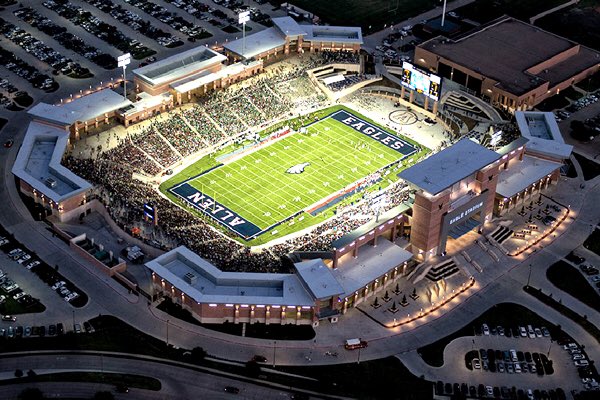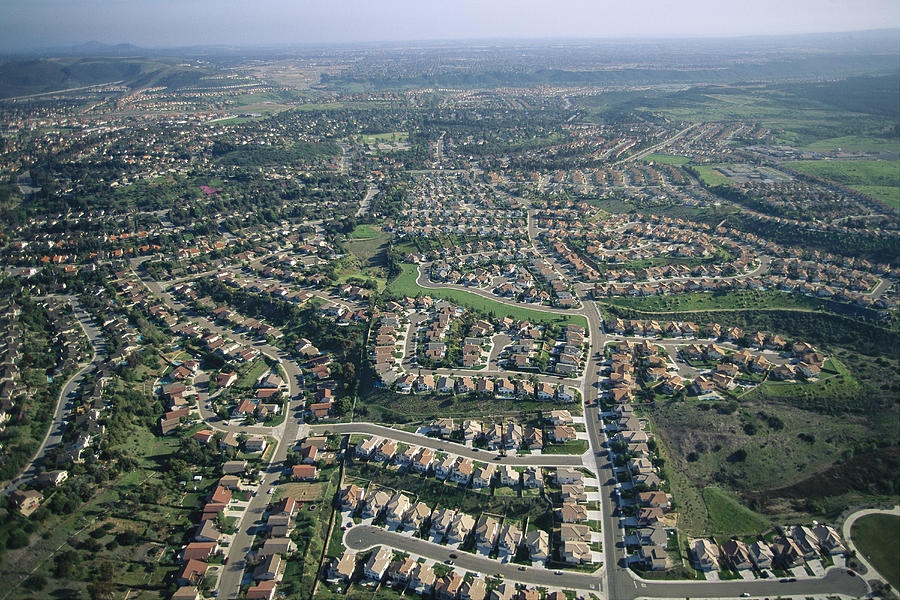
Changing gears from pro-sports to something a little different, this week I will discuss Texas high school football. They say everything’s bigger in Texas. This includes high schools such as Allen High School in Allen Texas, a North Dallas suburb, is the largest standard (not online or magnet) high school in the United States. Three of my cousins grew up in Allen and graduated from Allen High School. Allen, like many North Dallas suburbs, is quite affluent. You probably never would have guessed from Friday Night Lights and the fact that two Superbowl MVP quarterbacks (Drew Brees and Nick Foles) went to the same high school High School football is quite a big deal in Texas. As one from a state that is very large, very rich, and obsessed with football, the stadiums can get quite large. Many stadiums can be larger than Division II or even small Division I football stadiums. Many have to be shared between several schools and play their addition games at collegiate or sometimes even NFL stadiums. Another cousin of mine, for example, attended a high school in suburban Houston where the demand to go to his high school’s games got so popular that some of them had to be moved to NRG Stadium (the Houston Texans stadium).

The constant game of one-upping each other between Texas high schools has gotten a little out of hand but Allen High School outdid them all. In 2013, Allen constructed a $50 million, 18,000 seat stadium that includes 1,000 seats designated for their marching band (yes, they have a 1,000-person marching band!). This is the largest high school football stadium in the United States designated for a single high school. For perspective, the University of Villanova football team plays in a 13,000-person stadium. To make matters even more interesting, they chose to build their $50 million stadium on a sinkhole and the stadium was rendered unusable for over two years.

The reason for this seemingly excessive stadium is, according to many of the local residents, is that it fosters a sense of community. Collin County’s, where Allen is located, population has grown over five-fold since the early 1970s. For well over a century, most of Collins County was farmland, however when Dallas grew, it grew out. Take Plano, located directly south of Allen. During the 1970s, Plano High School was the perennial football power in Texas. However, as Plano continued to grow, the population outgrew, and naturally Plano East High School was created to accommodate the growing student population. Matter of fact, Dallas is the youngest city in America with 27.6 percent of all residents in the Dallas/Fort Worth Metropolitan Area under the age of 18. When Plano split into two high schools, many residents believed that Plano lost part of its identity and sense of community. Texas’s growing population included residents a diverse background of residents from all parts of the country along with Latin America. Allen, wanting to avoid the mistakes Plano made, kept their town unified under one school and one stadium.

While high school football can certainly help bring a community and I do not believe the people of Allen have bad intentions, $50 million is a lot of taxpayer dollars to spend on a high school football stadium. Especially one that was deemed unusable for two years. In addition, how big should a high school really get? Graduating with upwards of 2,000 other students is quite a lot. Perhaps Allen, and similar communities, should actually considering splitting into two, three, or even more high schools and perhaps share a stadium between them. Considering that in addition to High School stadiums, the Dallas/Fort Worth metropolitan area also features three major division I college football programs, several smaller colleges, the Dallas Cowboys, a Major League Soccer team, and the Cotton Bowl, there is no shortage of stadiums available on Friday night lights.

I’m not quite sure a solution to this odd conundrum. I obviously don’t want Texas High Schools such as Allen to lose a part of their community but because these are public schools and therefore funded by taxpayers, spending $50 million of high school football stadiums is probably fiscally responsible. It can drain resources from other areas that need improvement. Obviously Texas high schools care about more than just football, and many such as Allen perform in the top ten percent of high schools nationwide in SAT scores but it makes one question where some of their priorities lie.

FNL was the first thing that popped into my mind when I started reading this. I personally think that spending $50 million dollars on a high school stadium is ridiculous, but I’ve also never been to Texas! I guess it just shows how fundamentally different the U.S is across the country.
I agree with the question of priorities. I’m sure they do distribute the taxpayers’ money evenly on other situations. I think it’s the fact that they are able to spend $50 million on a stadium which is pretty wild. Although they probably don’t need to spend that large sum of money, they need to fit the crowd. I’m not sure why they thought it was smart to put it on a sinkhole, that defeats the purpose and you could question the usage of money there.
As the second biggest state in the America, Texas has approximately 29.1 million population in 2019. With such an enthusiasm of sports, there must be numerous gigantic stadiums in the state, which weighs a huge part in the state revenue taxpayers have turned in. You bring up a very good point that the state should not only concern about people’s interest in support big sports but neglect the actual sources it has. Especially for schools that whether their first focus is on sports or acdamics.
There was NO sinkhole. The stadium had some cracked concrete from improper curing, but the stadium was always structurally sound.